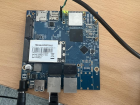
Wallys industrial wifi5 2×2 2.4G&5G router/ IPQ4019 IPQ4029 ,802.11AC MT7915/ QCA9880 APPLICATIONS Profi WiFi hotspot coverage Commercial radio coverage Hotel Wireless application Country coverage Internet for passengers (bus, train, plane, …) Security Surveillance Some special scene application Heavy-duty industrial environment use Featuring with industrial-grade IPQ4019 /IPQ4029 chipset Integrated with 2x 2 5G high power Radio module and 2×2 2.4G high power Radio module Support 4.940GHz to 5.825GHz Frequency Range Support 2.400GHz to 2.482GHz Support 2 x 5G MMCX Connectors and 2×2.4G MMCX Support 5MHz/10MHz/20MHz/40MHz/80MHz Bandwidth Support 11ABGN/AC Support fixed data rate RoHS compliance ensure a high level protection of human health and the environment from risks that can be posed by chemicals Our Firmware supports all the modules of Quectel MT7915 + MT7975 Chipset 2.4GHz max 23dBm & 5GHz max 20dBm output power IEEE 802.11ac/ ax compliant & backward compatible with 802.11ax/ac/a/b/g/n 2×2 2.4G & 2×2 5G MIMO Technology, up to 1.8Gbps Mini PCI Express edge connector SupporttheFrequency2412MHz~2482MHz SupporttheFrequency5180MHz~5825MHz RoHS compliance ensure a high level protection of human health and the environment from risks that can be posed by chemicals Supports Spatial Multiplexing,Cyclic-Delay Diversity (CDD), Low-Density Parity Check (LDPC) Codes,Maximal Ratio Combining (MRC), Space Time Block Code (STBC) Supports IEEE 802.11d, e, h, i, k, r, v time stamp, and w standards Supports Dynamic Frequency Selection (DFS) CardsareindividuallycalibratedforQualityAssurance We'll start with a quick review of how Wi-Fi has changed over the years. In fact, the earliest generation of 802.11 standard can be traced back to 1997, when the wireless speed is very low, only 2Mbps, it is an original standard of the first generation . With the introduction of 802.11b in 1999, the physical layer speed was increased to 11Mbps and there were very few commercial applications. At that time, Wi-Fi was still far away from people's lives In 2003, the third generation of the standard, 802.11a/ g. Laptop began to configure wireless network card and home wireless router appeared in large quantity . Wi-fi comes into ordinary family. EMAIL:sales@wallystech.com WEB: https://www.wallystech.com/ Youtube: https://www.youtube.com/channel/UClmu7LBz_OWxe2VckkQr3tw



 标签: router
标签: router